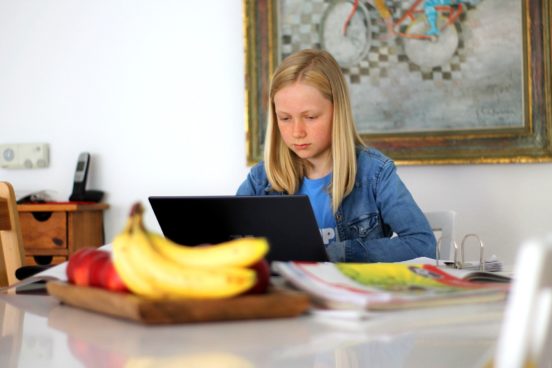Children and young people with disabilities or Additional Support Needs (ASN) and their families face particular challenges as a result of school closure and other lockdown measures (1). In school, pupils with ASN benefit from teaching and support that is often simply not available at home and parents may or may not have the time or expertise to provide this level of support. We know that children and young people with additional support needs are at increased risk of social isolation, mental health and reduced attainment.
Inclusive Digital Technology
The aspiration of Scotland’s Curriculum for Excellence is to “enable all children to develop their capacities as successful learners, confident individuals, responsible citizens and effective contributors to society”. So how can you become a successful learner if you can’t read books and learning materials? How can you develop your confidence if you depend on others to read to you or write for you? How can you exercise responsibility when you have difficulty understanding or expressing your views? How can you contribute effectively if you can’t speak, write or communicate? Here are some ways in which inclusive digital technology can provide positive answers to these questions:
- Learners with dyslexia or visual impairment who have difficulty with printed materials can access digital learning resources by altering the appearance of the text or by using computer readers.
- Learners who have difficulty with handwriting or spelling can type or use computer dictation.
- Learners who have speech and language difficulty can use electronic aids to communicate.
- Learners who find things hard to understand can be helped by picture symbol materials.
Learning at home
My unit, CALL Scotland, is funded by Scottish Government to research, develop and support the application of digital technology for children with ASN in Scotland. One of the ways we do this is through partnerships with local authorities where we support individual learners. Yesterday I had a conversation with a parent of a learner in 4th year at a mainstream school. She has Cerebral Palsy that affects her fine motor control and she gets sore and tired when she writes or types. At school she uses an assistant to take notes in class and to scribe her work; time-limited exams and assessments are a particular challenge. At home, the assistant is not available and it’s a challenge for her parents and to find time to scribe, so we agreed that we will evaluate computer dictation as an alternative. If this works out, there are many benefits: she will have a skill that she can use at home, at school, and beyond – she hopes to go to University; she will be able to work independently without needing to rely on others; and it should make life easier for the whole family.
Earlier this week a young man emailed to report that “I have got used to the Apple Pencil and I feel like a pro! I don’t use the extended keyboard as I use the touch screen keyboard because I find it easier. I don’t have to push a key down, I just tap it. I bet a feather could type on a touch screen. All the teachers are now using Teams or Show My Homework which is really good for me and makes the iPad incredibly useful. I am getting quicker and enjoying online learning.” At school, this learner’s physical disability meant that he too had relied on a scribe in class. Not long before school closure we loaned the technology for him to trial and it’s clear it’s helping him to develop his confidence and independence. Learning at home also suits him: he doesn’t need to leave early to wheel himself to the next class, and he can do his schoolwork when he has time and energy.
Digital Divide
However, we know that there is a digital divide (2)(3) and that the situation in other households is quite different. Even though digital technology has never been cheaper, more prevalent or more accessible (all the mainstream devices now have pretty good accessibility features), children need access to a device, they and their families need the skills to use it for learning, and teachers need to know how to create and use accessible digital learning resources. We know from calls, emails and social media that many families do not have access to the technologies or the skills to use them effectively.
Independence
Throughout my career I have worked on technology in many different forms, from the CALL Smart Wheelchair in 1988, to SQA Digital Question Papers in 2008, but the driver has always been a desire to help people with disabilities to be successful, happy and independent. For many of us, digital technology makes life easier and more convenient (although not always, as we gaze with despair at an incomprehensible online form, or struggle in vain to find the document we thought we had saved but apparently haven’t). For some people with disabilities though, technology is absolutely vital – it is the ONLY way to read, write, communicate, research and access learning independently.
During and after Covid-19
In Scotland we do OK with Inclusive Digital Technology. I give us 6, maybe 7 out of 10. We have Glow, free access to Microsoft and Google products, and a relatively good pupil to device ratio. Where we could do better, according to a new OECD report (4), are in the provision of adequate broadband, professional development, and digital pedagogy and expertise. With regard to assistive technology, we have a small number of specialists working in some parts of the country, and CALL provides free accessibility tools, the free Books for All online database of digital textbooks, free Scottish computer voices, free symbolised materials, and free information and advice. But assistive technology isn’t magic, it’s a specialised field, and in too many areas of Scotland learners and families do not have appropriate assistive technology or to skilled practitioners who can help. We need to, must do, and can do better, to enable learners with ASN to reach their potential.
This article was originally published here: https://www.ed.ac.uk/covid-19-response/expert-insights/making-the-most-of-inclusive-technology-during-cov
Paul Nisbet is a Senior Research Fellow at Moray House School of Education and Sport at the University of Edinburgh, and Director of CALL Scotland, a Knowledge Exchange and Transfer Centre within Moray House. CALL (Communication, Access, Literacy and Learning) Scotland is the Scottish centre of excellence in the application of technology to support pupils with additional support needs.
(1) Scottish Government (2020) Vulnerable children report: 15 May 2020
(2) Office for National Statistics (2019) Exploring the UK’s digital divide
(3) Scottish Government (2020) Schools to re-open in August
(4) OECD (2020) A framework to guide an education response to the COVID-19 Pandemic of 2020










Comments by Ritti Soncco